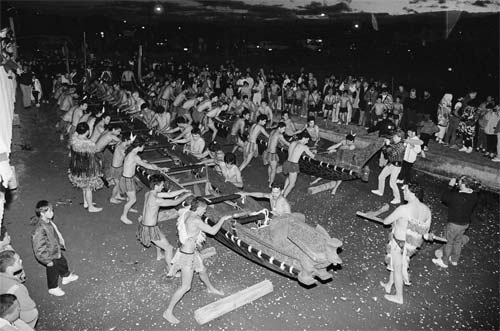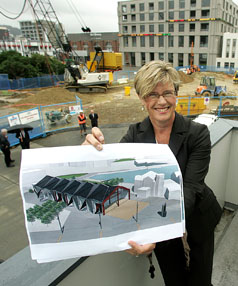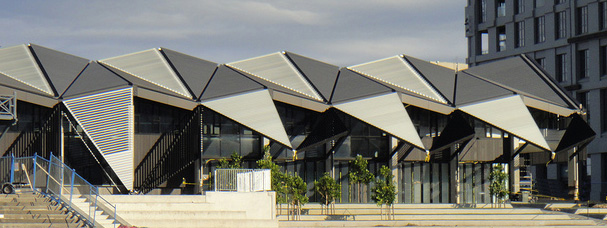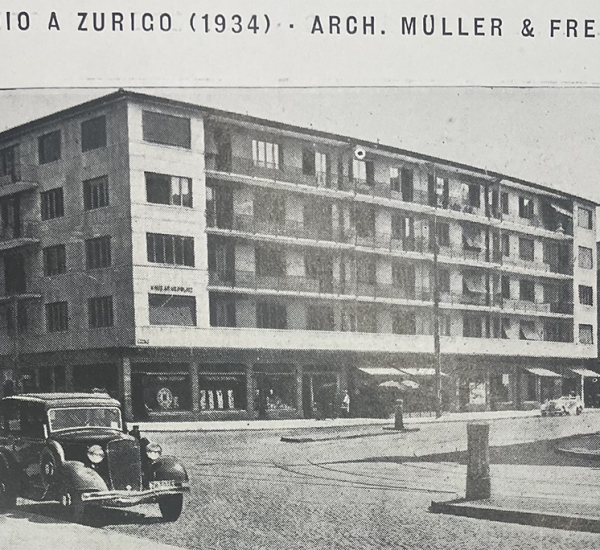Whither to, waiwhetu…
While we’re waiting with willing Waitangi welcome, windy Wellington’s waka wends wetly with Waiwhetu, where wrangles wearily wear worrisomely. What will we watch? Worry while we work!
Yes indeed, the much awaited day dawns, and the whare waka will be named at a dawn ceremony on Waitangi day – this coming Sunday.
The building has had financial input from the Tenths Trust (local / Taranaki based iwi Te Ati awa), but the major funding has come from central and local government, in part at least as retribution for the pathetic attempts over the years for the government to live up to its side of the treaty promises. There’s a pretty shabby history there, with, yet again, broken promises regarding tino rangatiratanga. The long and short of it is that the Tenths Trust was set up in Wellington to administer the remaining tenth of land that was reserved for Maori – and yet even that deal was reneged on many times. Sigh. Crappy broken politicians promises. Well, we can at least have a look at the building next week, and for a start, a look at the history behind the building.
The construction project appears to have gone quite smoothly, which is more than can be said for the planning process to get it there. Way back when, there was a proposal to have 2 buildings on site – from memory, one a whare kai, and one a whare waka. They’ve now both been amalgamated, and this was partly in answer to continued opposition at the time from the boating clubs nearby. The boaties were complaining that there wasn’t enough room for their trailers full of boats to be stored, or backed, although there was some suspicion at the time that this was just a thinly disguised attempt to not have to share their shingle spit with anyone else.
Wellurban reported on this several times back in 2006, like here, and also here, and here as well – but the annoying thing is that all the articles at the WWL website have been deleted – so we can’t go back in history and see what the original depictions were like. Perhaps architecture + could send us an old picture – but in case they don’t, just close your eyes and imagine one smaller building by the bottom of the City to Sea bridge, and another where the current wharewaka is.
The building will suffice not just as a home for the waka, or wakas, but also as a whare kai – or perhaps even a whare pia. It is not yet a whare wakairo, but it will be both a museum-ish home, as well as a living venue for – presumably – not just the waka themselves, but local iwi as well as rentable space for weddings etc in the same way that the nearby Star Boating clubrooms also stand in for things Wellingtonian. In a well timed move, it will also be ready as a venue for Wellington’s rugby world cup celebrations later in the year – but, opening on Sunday the 6th, will not be quite ready for a trial run with the Sevens tournament this week.
But will we actually have a waka to store in our whare? Or if so – which waka will we have? The Dom Post reports that : Waka tipped to turn up for wharewaka ceremony and notes that while “a deal is believed to have been done” to allow “Wellington’s waka” to take part in a Waitangi Day dawn ceremony to open the waterfront’s new $12.5 million wharewaka.
Rival factions of the iwi, Te Atiawa, have been involved in long discussions over the ownership of two canoes housed at a museum in Waiwhetu, Lower Hutt – Te Raukura, also known as Wellington’s waka, and the Hutt Valley waka, Te Aniwaniwa. For the past three months Waiwhetu Maori leader Kara Puketapu and Port Nicholson Block Treaty Settlement Trust chairman Sir Ngatata Love have been engaged in talks over whether Te Raukura should be housed in the new wharewaka, or canoe house, as intended by the wharewaka’s designers. It is understood a deal has been done to allow the two waka from the Waiwhetu museum be present at the dawn ceremony.
Waiwhetu Marae chairman Kura Moeahu said his people had no idea what was going on in the discussions involving Dr Puketapu and Sir Ngatata. “The people of Waiwhetu are not happy. They have been left out of the discussions,” he said. The dispute between Sir Ngatata and Dr Puketapu is long-running. Dr Puketapu believes the Port Nicholson Block 2008 Treaty settlement did not adequately address the Waiwhetu compensation issue in the $25m cash and property deal. The return of the Te Raukura waka has now become caught up in the continuing dispute.
Messy, messy. A real pity too – it would be nice to have the occasion unsullied by controversy. The waka themselves are bound to be fantastic – here they are waka being launched, way back when, in 1989:

“The waka taua (war canoe) on the left is Te Aniwaniwa, and the one on the right is Te Raukura. They are the work of master carver Rangi Hetet and his assistants. The vessels are being prepared for their dawn launch onto Wellington Harbour in 1989.”
Alexander Turnbull Library, Dominion Post Collection (PAColl-7327)
Reference: EP/1989/4602/17A
Photograph by Phil Reid
Alexander Turnbull Library, National Library of New Zealand, Te Puna Matauranga o Aotearoa.
A question for you all: If the waka concerned has been built by Te Ati awa, with the involvement of Sir Ngatata and his iwi, should we not know it as “The Love Boat” ?
(Sorry, but couldn’t resist that. The Love’s are one of the most respected families in local / taranaki maoridom – descended from John Love, who, along with Richard Barrett and other early whalers and traders, were very influential back in the hapu back in the 1830s – If you would like to read more, go to this site here at the Journal of Polynesian Society. History and traditions of the Taranaki coast. Chapter XVIII The defence of Otaka or Nga-motu).
So, while we’re still unsure which waka will ultimately live in the whare, and exactly what it will be used as by the providers of the said canoe house, the building itself is well overdue and will be a welcome addition to the foreshore of Wellington harbour.
Well, its not welcomed by everybody apparently. Wellington Scoop had a go at it last year, with local editor Lindsay Shelton (ex-Waterfront Watch) having a go at it for partially blocking the view from the top of the City to Sea bridge, over to that marvel of architectural brilliance, Te Papa. No mind that Te Papa is an ugly and unloved monster that most of us would rather forget, Shelton had a good go at the WCC for not obeying its own Design Briefs about keeping a clear view through to Te Papa, but got short shift from the normally friendly WCC spokesperson, Richard MacLean: ““We have all been busy with more pressing projects,†wrote council communicator Richard MacLean. He added: “Unfortunately for you, the council is not obliged to leap to attention … every time you publish a piece.†…. “It will ultimately be a decision based on work priorities as to whether [our planners] respond or not.†Hmmm. What I think we can read from that is that the Council backed project was not going to have its roof removed and lowered at this late stage. Certainly the last Mayor was very keen on it!

And I strongly suspect that the new Mayor will be just as keen.
So: what do you think of it?





From a perspective of form, I find it quite heavy. It’s not a bad building, and in fact has some interesting things going on in its overall form, but it is the distinction between the box and the roof that I find distressing. The roof is too thick and bulky to really feel like a folded plane, and it is too rigid with the ends of the building to feel like it is meant to be a folded plane on top of a box. However, the box doesn’t have enough integration to feel like they are meant to be one form. The ends of the building, at least to me, seem to be referring to traditional maori construction methods, which means that there are 3 forms which are fighting for primacy. I feel like the hierarchy of these three form hasn’t been resolved. I think that all the forms are in the same colour and materials only contributes to this difficulty in reading. It’s like it’s meant to be read as one singular form, but then it’s not fully embracing that.
So we have a waka shed but no waka. And we might not have any waka unless we agree to re-open a settlement that was, errr, settled. I hope someone has a Plan B for something to put in to the shed in the event that the council doesn’t give in to blackmail.
I think the shed looks quite cool. I’m looking forward to seeing the insides, and the outsides without a fence being in the way.
blackmail is such a harsh word. Shall we just call it, in the wake of Harawira, protracted negotiations….
There are, of course, many waka down there by the sea. Most of them are the pacific dragon boats, but there are also 2 man skiffs, and 8 man sculling hulls. In short, there would be no shortage of people wanting a place to store their piece.
But the waka taua, that’s a different story. They’re pretty magnificent beasts, especially when they are in full paddle. The one being held in Waiwhetu is next to a stream (recently cleaned up from toxic waste) but it is hardly the best place to launch a true warrior waka. For that reason, I’m hoping that the waterfront whare waka wins out – so we can see it launched as often as possible.
I’d love to see it in the new building too… but not enough to abandon a treaty settlement and begin several more years of negotiation followed by a multi-million dollar payout.
I went for a walk along the waterfront this evening after work and it was end-to-end boats. The Velux 60s, dragon boats, kayaks, and some from the rowing club. They’re much better afloat than inside a building. I’m going to try and get up for the Whare opening on the 6th, events of the evening of the 5th permitting. But what I’m really looking forward to is the re-start of the Velux later in the day.
I personally despise the building.
I work in the nzx building, and used to have an almost unobstructed view of the harbour from my cubicle.
Now I have a view of some nasty concrete and cheap/nasty sheet steel, and a broken, jumbled expanse of reflections from the roof.
It is also quite definitely bigger than the drawings that were distributed around our building some time ago, which also appeared on the information boards around the construction site. I suspect the (elevated) perspective used for the drawings also worked to conceal the planned size of the structure.
My friends and I used to play frisbee in that space at lunchtimes, and I liked having open waterfront space. underdeveloped though it may have been.
The only good thing I can say about it is it will permanently prevent a recurrence of the vodafone music festival placing their thrice damned marquee in front of our windows, which used to be perfectly aligned to reflect sunlight and glare into our office, triggering mass headaches and migraines.
Aaah, Nick, yes – I’ve often wondered about the effect of the waterfront events on people in the old Odlins building, especially in the upper floors, where the rich toffs live, soaking up the noise from the feral skateboarders down below. While the new waka house is aligned with the St Johns building, at the angle it is, it will be causing a big disturbance in the local marque erection stakes. Those migraines may continue on…
I would suspect that while the wharewaka will take the place of the marques to a certain extent, it will only hold so many people – and the remaining space will probably still get let out for temporary events. But, then again, the greater good of Wellingtonians must surely win out over the viewshaft requirements of the workers at the NZX ? And I suspect that you’re not going to get a whole lot of sympathy, being as your office is situated right over two of the greatest locations for drinking in the whole Wellington region. St Johns in particular is a special place – and now, with new landscaping, possibly even better?
Nick>My friends and I used to play frisbee in that space at lunchtimes, and I liked having open waterfront space. underdeveloped though it may have been.
Huh? You chose to accept a job that requires you to work in a developed non-open waterfront space, namely the Odlins Building.
I find the idea that the rest of us shouldn’t enjoy public amenities on the waterfront so that you and your friends get to play frisbee with a view of the sea to be less than compelling.
Well, I’ve changed my tune on this, upon seeing its near-completed form.
Size: still think it’s a bit bulky height-wise, with the roof being my main irk. Sure, breaking up roof uniformity is great but this is just a bit too up-and-down for my liking.
Placement: going past it this week, the alignment of its frontage with the Kupe statue is fantastic, as is their development of the lagoon. If only it had been placed a _little_ further away from existing buildings, you would have been able to see the form and outline of the building on its own from more angles. It just feels a bit closeted in.
Need for it all: having been filled in on the history a bit more, sure, why not? It sure makes the space a bit more lively, even if the whole situation looks like it gives the finger to the honky rowing club establishments (who Maori felt had probably given them the finger in the first place).
I just hope their internal squabbles get solved internally and in time for the opening.
Overall, I think that Tenths have got an outcome that is as near to perfect for them as they could have got. Well done.
WCC news just in : http://www.wellington.govt.nz/news/display-item.php?id=4302
A dawn ceremony on Waitangi Day will mark the opening of the Wharewaka o Poneke near Taranaki Street wharf – a significant event for Wellington.
A showcase for Maori culture and the base for the Rugby World Cup 2011 village
The Wharewaka is an important new addition to Wellington’s waterfront and reflects the city’s commitment to mana whenua. It was specifically designed to house the Wellington City waka, Te Raukura. Construction of the Wharewaka began in January last year and Mayor Celia Wade-Brown is delighted to see it finished.
“Wellington should be very proud of this building. It’s a building you couldn’t see anywhere else in the world. Taranaki WhÄnui ki Te Upoko o Te Ika have delivered Wellington a wonderful asset that reminds us all of their place in the city – their history on the waterfront and their future as well.”
The Wharewaka has exhibition and function areas, a cafe, commercial kitchen and office space. It will host pÅwhiri and cultural performances, and feature carvings and interactive history displays. The building highlights the mana of Taranaki WhÄnui ki Te Upoko o Te Ika on the waterfront in an area originally occupied by tÅ«puna.
Sir Ngatata Love, chairman of the Wharewaka o PÅneke Charitable Trust, says he’s excited to see the Wharewaka open. “This has been planned since the 1990s and I’m delighted we’re now able to bring waka culture to Wellington’s waterfront.”
The Wharewaka’s exterior design is based on the form of a korowai (cloak), which has in recent times come to reflect mana and prestige. The korowai design is based on the traditional sails of the waka fleet and louvered metal panels symbolise the cloak’s arms draping over the sides of the building. The Wharewaka’s maihi or bargeboards, where the external walls meet the roof, also reflect the design of a waka.
The earliest Wellington explorers are linked with the waka of today through the buildings relationship with the Kupe group statue beside it and the representation of a traditional Polynesian navigation aid, the star compass or aronga mana, at the front of the Wharewaka. The Council committed $1 million to the $11.5m project – other funding came from the Government ($7 million), Port Nicholson Block Settlement Trust, Wellington Tenths Trust, and the Palmerston North MÄori Reserve Trust.
The Wharewaka will be the centrepiece of Wellington’s Rugby World Cup 2011 (RWC 2011) ‘fan zone’. City Councillors voted, after public consultation, to spend $100,000 in 2010/11 and $50,000 in 2011/12 as part of the Annual Plan to create the fan village around the Wharewaka, which will be leased for the duration of the tournament.
The Council is working with the Trust on a programme of activities to provide a unique cultural experience for visitors and locals during RWC 2011. “We’re very proud that our celebration of this global event will showcase MÄori culture and specifically the important role of mana whenua,” says Mayor Wade-Brown.
Sunday’s dawn ceremony is for invited guests but anyone can watch it live on the big screen at Odlins Plaza (by the former Free Ambulance building) from 4.00am. The whare is not named beforehand, as it is asked to reveal itself as part of the opening ceremony.
Delicious kai will be available from MÄori and Kiwiana stalls selling breakfast and lunch. Throughout the morning there will be cultural performances, including singer Toni Huata, watersports demonstrations by ceremonial waka and Waka Ama, storytelling and the traditional MÄori Ki-o-rahi. Guided tours of the Wharewaka will also be available during the day.
>It was specifically designed to house the Wellington City waka, Te Raukura.
Hmmm… that is a different statement from “It WILL house the Wellington City waka, Te Raukura.”
>Sunday’s dawn ceremony is for invited guests
So don’t bother turning up if you’re just an ordinary Wellingtonian… This is an event for important people only.
I get the feeling we’re going to end up with a council-owned pub for rugby fans. Who’d probably prefer C-Place anyway.
Love it. Any building in the city that moves away from the vertical glass curtain walls and concrete panels gets my vote. We need more dynamic architecture like this in Wellington.
Not sure whether Nick was trying to be funny, trying to be provocative, or whether being in the confines of his cubicle for too long have damaged his ability to see outside of his own little world.
Is it just me, or are you all finding a glitch on the home page at present? We’re trying to fix it….
Hate it with a passion. In simple terms: it’s four times the size it needs to be, it’s inwards looking, half of it is just horribly blank walls, and nothing about it says, “Come over here and check this out.” It looks more like some kind of conference centre cum tarted up substation. I’d have preferred to see a smaller building (or multiple smaller buildings if need be) to scale with its primary purpose. Something more open so you an get a feel for what it’s purpose actually is from afar without having to go inside. And less opaque/more transparent, or repositioned/broken up so that it doesn’t completely disconnect the City to Sea Bridge and Lagoon from Te Papa and the open space in front of the Odlins building.
I would echo erentz’s comment about transparency. I suppose there are two typical ways to display something precious – either put it on display, or demonstrate it’s being safely kept. I was holding my opinion until it was opened to see how the functions and activities worked out with the exterior presentation, but at the moment, I’m not seeing much transparency going on.
And in Stuff today:
http://www.stuff.co.nz/dominion-post/news/4611071/Dispute-keeps-main-guest-away-from-wharewaka-opening
A canoe-house without a canoe. Pathetic.
Also the cost of transporting the Whakatane waka down is not inconsiderable. Who is paying for this? Is it the ratepayers, who have already been lumped with the re-hulling cost and the rent to house existing waka?
Re : “A canoe-house without a canoe. Pathetic.”
No not really. Following Maori protocol, it is entirely appropriate that a Whare be opened / blessed without anything in it.
What I would like the Dim Post / Stuff do is a bit more investigation into the nature of the dispute between the two parts of Te Atiawa in question. My understanding is that there is a schism between the small Wellington-based elite consisting of the Love family and their various hangers-on who are doing quite nicely and the larger group who were originally based at Waiwhetu. The Waiwhetu branch had much of their land taken in a Public Works Act land-grab in the late 1940s for State Housing but Ngatata Love lumped all of Te Ati awa’s claims together. The Waiwhetu branch would have liked to have used compensation awarded for the loss of their land for activities / social support services associated with the Waiwhetu Marae but instead it has gone into a pot largely controlled by Love (and used to build things like Whare waka….).
[…] this week, a reader of the eyeofthefish blog alleged that the building is bigger than the drawings which appeared on information boards […]
The Arch Centre website has also published a review of the Whare Waka, centering around the external landscaping to the project:
http://architecture.org.nz/2011/02/03/wellington-whare-waka/
It notes: “We’re going to devote some room to an an-depth discussion of the building in our next Arch Centre newsletter, due out soon, where we will have a full architectural review, but in the mean time it is kind of hard to ignore – and so this post just touches on the context of its surrounding landscape. Which is, at present, all we can really see.”
While the Jpegs have gone from the WW site, the original PDF is still there
http://www.wellingtonwaterfront.co.nz/docs/taranaki_street_wharf.pdf
and to be honest, I think the outcome is better than what was originally proposed
Thanks for the link, greenwelly. Apart from anything else, it shows that there were always intended to be several functions fulfilled by new buildings around the lagoon: a functions space, powhiri area, café, gallery and waka display space. These would originally have been in two separate buildings (Wharenui and Wharewaka), but then it was decided to amalgamate them into one building. Even if that building is without a waka for a while (until Te Atiawa sort themselves out) it will still fulfil the other functions that were part of the original brief.
Of course, the blatherings over on Scoop choose to ignore this, with rantings about it supposedly being “downgraded to become a place for parties and the sale of souvenirs”. It was always _intended_ to be a place for parties and other gatherings, as the WWL PDF says: “Te Wharenui will be multi-functional, providing a mid-sized venue for cultural and social events and conferences.” It just so happened that the RWC came along, so that within six months of opening it will have one particularly large booking for a series of social events, which incidentally saves Wellington some of Auckland’s hassles with creating a fan zone. So, not just a “council-owned pub for rugby fans”, davidp, but a multi-functional building that with any luck will bring a lot more activity and interest to that part of the waterfront.
Hold on – this sounds like a complete cock-up:
http://www.stuff.co.nz/national/4678064/Whare-too-small-for-waka
“The long-running saga of Wellington’s wharewaka has taken a new twist, with the city council conceding that the $12.5 million building is too small for one of the waka expected to be housed in it. The admission comes as defiant Waiwhetu Maori ignore a council deadline to return Wellington’s ceremonial waka, Te Raukura. They also say plans to house the waka alongside “1800 drunks” in the party central zone during the Rugby World Cup are culturally insensitive and insulting to Maori principles.
“We all know what happens at party time,” runanga executive officer Teri Puketapu said. “We don’t want our waka in the middle of 1800 drunks.”
Wellington City Council admits Te Raukura’s Hutt Valley sister waka, Te Aniwaniwa, will not fit in the wharewaka, but says it was never meant to. Spokesman Richard MacLean said that, although the building was designed to house two waka, Te Aniwaniwa, the longer canoe, was not one of them.
“It appears whoever designed the thing, they obviously decided that, `No, it’s not going to house the Hutt one’. It sounds like another dispute.”
Mr Puketapu said the wharewaka was meant to house Te Raukura and Te Aniwaniwa when used together in Wellington.
That doesn’t entirely surprise me. When I see a long thin building, I think that the long thin things within would be running in the same direction, along the line of the building. It does seem very strange to just have the canoes at right angles to the main bulk of the building. And would also stop anyone from building a longer canoe in the future, without it having to stick out the side.